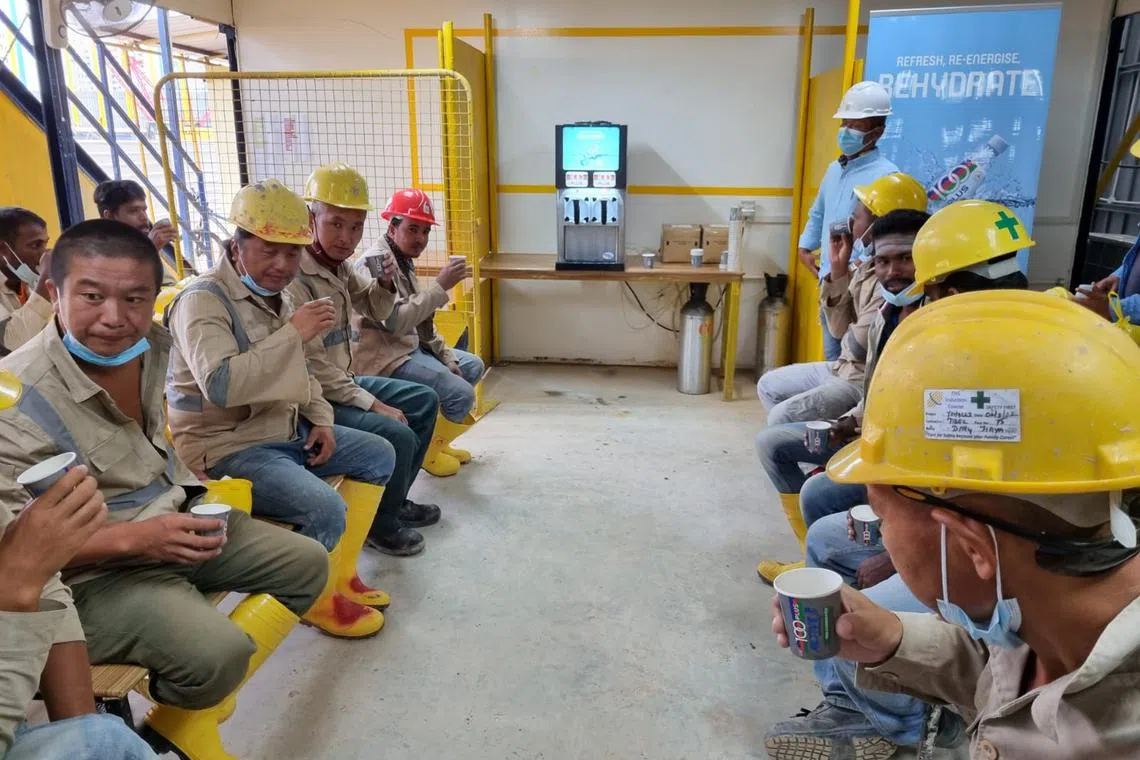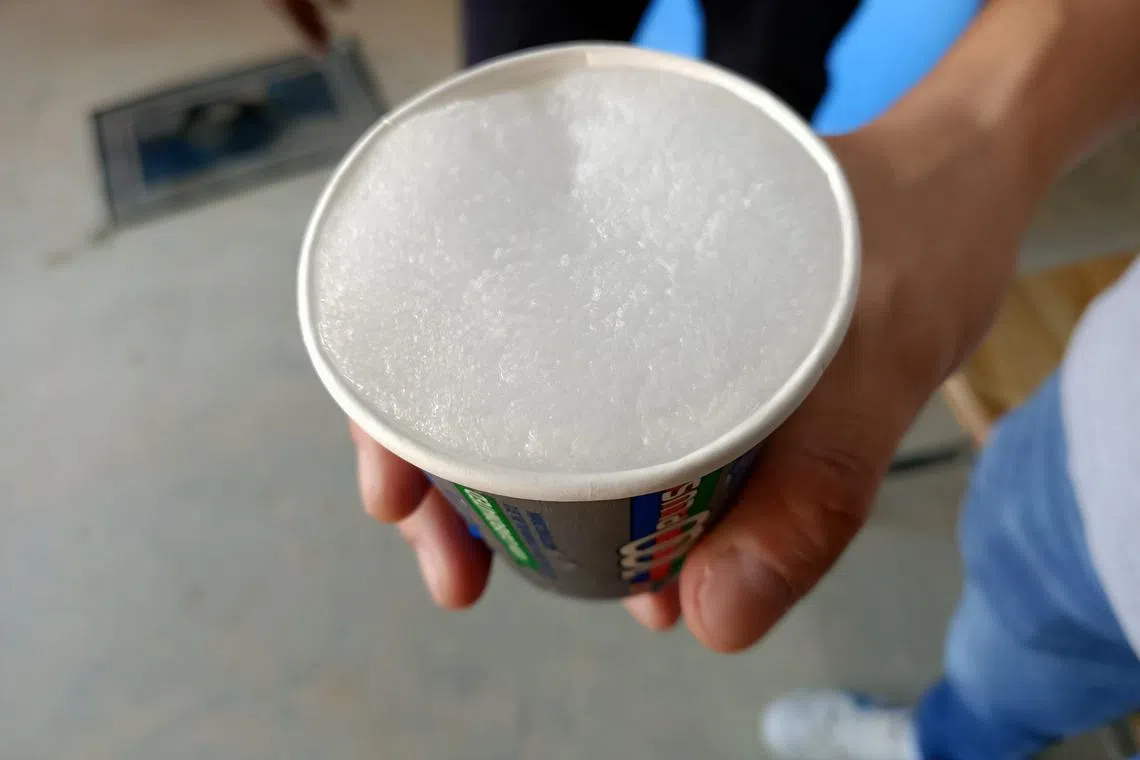Ice slurries one option being tested to keep construction workers cool
Sign up now: Get ST's newsletters delivered to your inbox

Workers at an outdoor construction site in Yishun have an ice slurry made from a dispenser during a break in July 2022.
PHOTO: MINISTRY OF MANPOWER
Follow topic:
SINGAPORE - In July 2022, more than 200 construction workers in Yishun were given specially concocted ice slurries – a refreshing drink to fight heat strain and exhaustion – during their breaks.
While the frosty drink, nearly sugar-free and isotonic, was foreign to many of the workers, it did the trick.
It helped to lower their core temperatures – the temperature of their internal organs – as they worked under the scorching sun.
Those who drank the slurry had a lower risk of heat strain, and they said they felt cooler, better hydrated and more energetic, said Ms Adeline Ng, director of the Ministry of Manpower’s Workplace Safety and Health Institute (WSHI).
Heat strain is the response of the body to effects of a scorching environment or heat stress. Heat-related illnesses can cause injuries, loss of productivity and even death.
Construction workers are one of the most vulnerable groups to heat stress, alongside seniors, outdoor cleaners and factory workers in unventilated environments, among others.
The ice slurry is among some solutions that WSHI and researchers are exploring to help construction workers fight exertional heat strain.
The trial was done in partnership with the Singapore Contractors Association, F&N Foods, kitchen equipment supplier Simplex, Teambuild Engineering and Construction, and researchers from Project HeatSafe at the National University of Singapore (NUS) who are investigating the effects of rising heat on the health and productivity of people in South-east Asia.
Project HeatSafe is testing some interventions at a Housing Board construction site in Woodlands under BHCC Construction.
The firm’s operation director Joseph Chua said the measures will include enforcing breaks under the shade, getting new workers’ uniforms that are breathable and ultraviolet-protective, and educating workers about heat stress in their native languages.
BHCC has put in place practices to manage heat stress since 2018. These include heat acclimatisation programmes for new employees and water breaks five times a day, encouraging workers to drink at least 500ml of water each time.
BHCC employee Akram Md Wasim said he and his colleagues tend to feel unwell and dizzy while working between April and June.
“When we feel unwell, we will go to the shelter and drink plenty of water. Once our body temperature cools down, we continue with work,” added the 29-year-old.

Construction workers are one of the most vulnerable groups to heat stress.
PHOTO: BHCC CONSTRUCTION
Parts of the region, including Malaysia, Thailand and Vietnam, are also broiling under the heatwave.
Singapore matched its highest temperature ever recorded from 40 years ago when the mercury hit 37 deg C last Saturday.
Weather and climate scientist Koh Tieh Yong from the Singapore University of Social Sciences noted that Singapore’s temperature is unlikely to exceed Malaysia’s at this point since sea breezes over the island state help to slightly bring down the mercury.
On April 22, the temperature in the Malaysian state of Negeri Sembilan hit a scorching 38.4 deg C.
When Project HeatSafe measured the environmental conditions of 19 outdoor worksites in Singapore through 2022, it found a troubling pattern – workers were exposed to high heat stress conditions several times in the year.
Using the most common measure for heat stress, the wet bulb globe temperature (WBGT), researchers found that the average highest temperature at each of the 19 sites was between 33.5 deg C and 34.4 deg C, exceeding the threshold of 32 deg C that signals high heat stress. The WBGT considers factors including air temperature, humidity and wind speed in a particular area.
“Workers were working in high heat stress risk situations chronically, and this comprises environmental conditions, long-sleeved and non-breathable clothing, and laborious work. Extreme heat not only degrades health and work productivity, but can also compromise decision-making, leading to accidents,” said Associate Professor Jason Lee, who leads Project HeatSafe.
Ice slurries are more effective than iced liquids in lowering core temperature because they contain many small particles of ice, which have a greater surface area for heat transfer to cool down the body, said Prof Lee, who is also the director of the Heat Resilience and Performance Centre at the NUS Yong Loo Lin School of Medicine.

The ice slurry, which contains less than 5 per cent of sugar, was created by F&N Foods.
PHOTO: MINISTRY OF MANPOWER
When ice slurries are ingested, heat from the body will melt the ice particles, lowering a person’s core temperature, he added.
But while effective, scaling up the ice slurry project could be a hurdle. WSHI’s Ms Ng said the manual dispensing machine used in the trial may not be suitable for rugged environments.
“Concerns were also raised by supervisors on potential challenges such as cost and manpower constraints to man and maintain the machine. Hence, we are continuing to study the viability of using ice slurry as a long-term solution,” she added.
F&N, which formulated the slurry that contains less than 5 per cent of sugar, is also exploring other solutions that will be more practical to be used on-site.
Associate Professor Koh also noted that the dew point temperature is the highest here between April and May, and this makes people feel more sticky and uncomfortable as such conditions prevent the body from evaporating sweat easily.
Dew point temperature rises mainly because of an increase in the amount of water vapour in a mass of air at constant pressure.
The high dew point now is due to the mix of rainy days and greater evaporation during the sunny periods, leading to more water vapour in the air, said Prof Koh.
This article has been edited for clarity.


